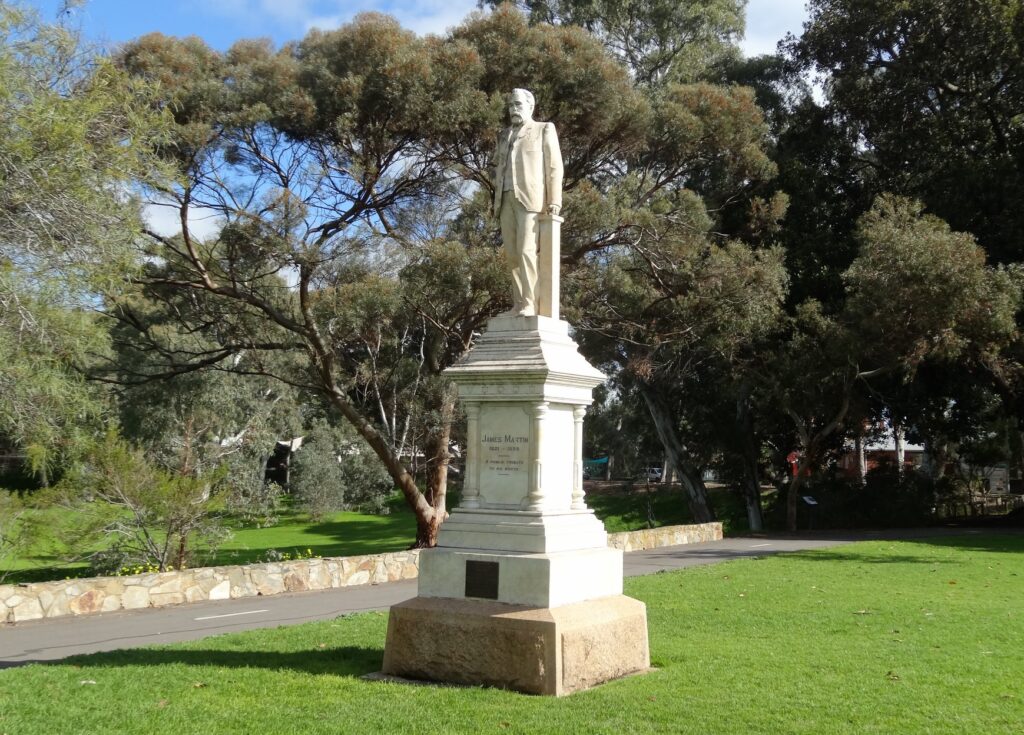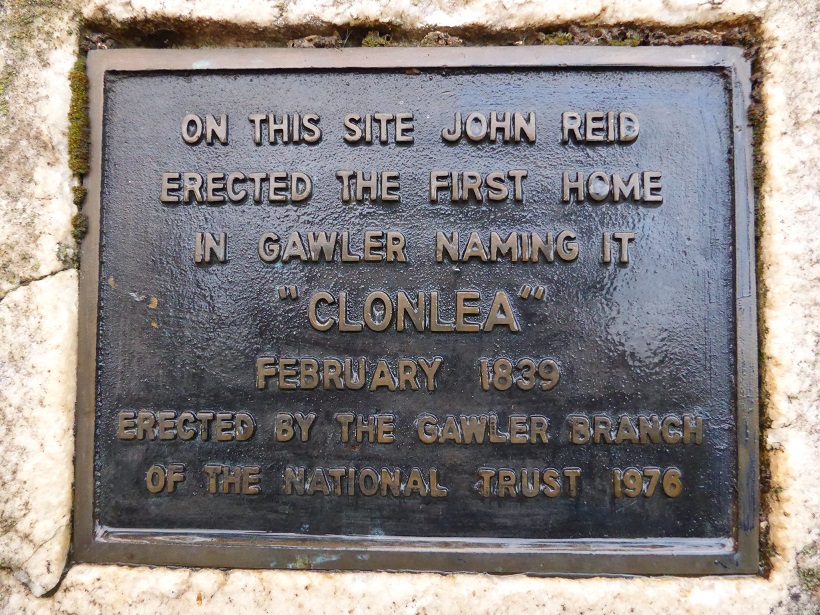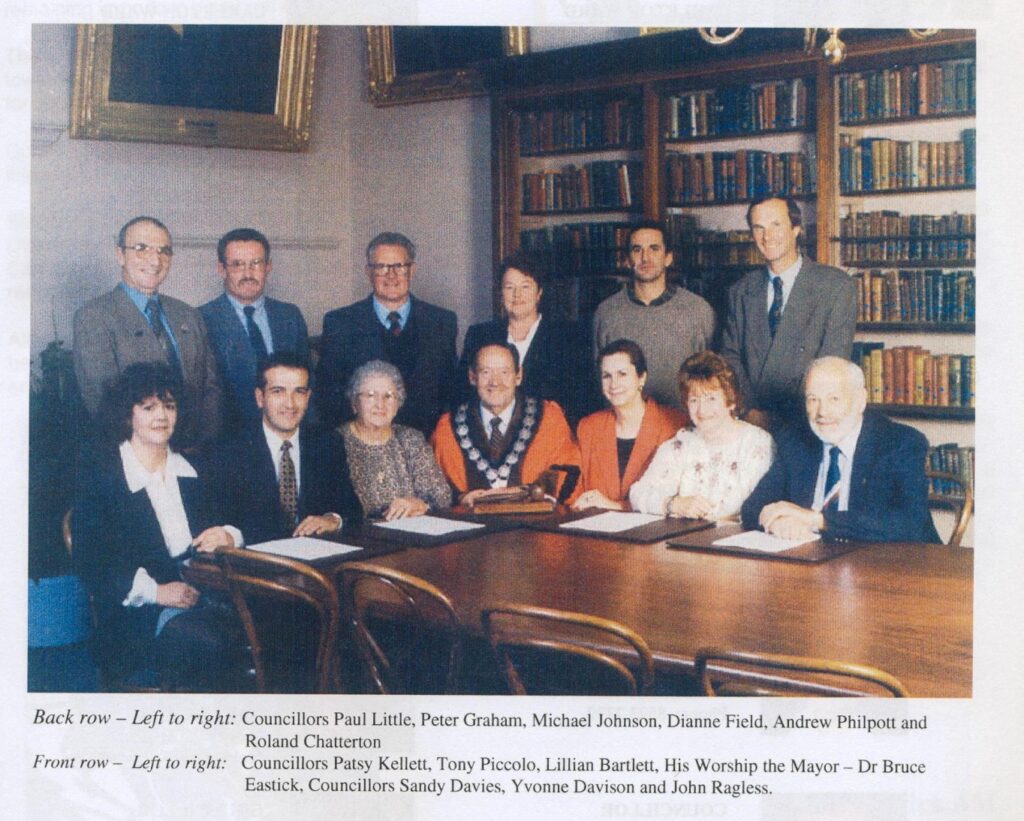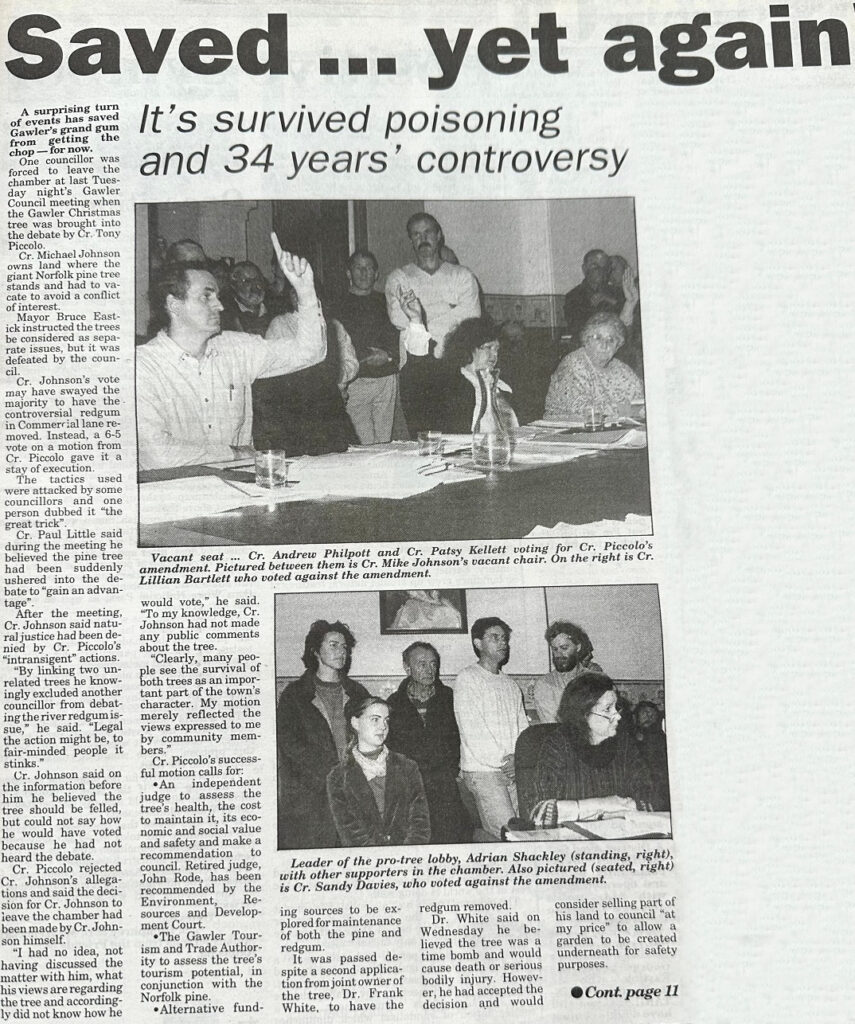It was the year 1997. The Spice Girls were telling everybody how much they really really wanted to “zig-a-zig ahh”, and society was only three years away from returning to the Stone Age due to the total collapse of all technology in the Millennium Bug incident.
This year also marks Gawler’s final ward elections (but our first). In fact, we’ll be operating under wards from now on in this blog, so I’ll give them a proper explanation to start us off.
Introducing the Ward System
Here is a map of how Gawler voters would have been divided into six wards between 1993-1997. The actual street map here is a 2023 Google Map (hence the modern landmarks like Drakes Gawler East), but I’ve drawn the wards over it so you can see the suburbs they covered.

The current Council border does look kind of like a sideways-facing dog, which might be the most convincing argument against boundary reform that I’ve heard so far. Maybe we could come to an agreement with neighbouring Councils to shape the boundaries into a new animal?
In the end, you don’t need to memorise any of the wards, as they will not be on the test. The wards system itself goes back to the founding of Gawler, but the actual borders change regularly enough, and their names change a few times too.
Another thing to note is that a wards system drawn today would not look like this, as the population balance has changed. Older areas of Gawler (like the suburb of Gawler itself) have remained the same population-wise for a long time, whereas other suburbs have had massive changes in the meantime.
In particular, the southern parts of Gawler have grown (mostly the suburbs with Evanston in the name). If there are six wards, each one should represent approximately 16% of the population, but these days, the areas covered by Martin and Reid Wards would make up around 45% of the population between them, not 32%.
Now, onto the elections.
The Mayoral Election (there wasn’t one)
If you remembered what I said in my last blog, you would know that Bruce Eastick was not challenged for his Mayoral position between 1993 and 2000. That is to say, this is one of those “win by default” years.

The Bunyip, April 3rd, 1997.
In fact, in a first for this blog, some, but not all, Councillors were also elected unopposed – a quirk of the ward system. We’ll cover the other winners later, but you might spot some familiar faces in that photo.
The Councillor Elections
I’m still figuring out how to structure these blogs going forward; now that we have a ward system, I’ll probably run the wards one at a time, but I still want to share the full list of candidate profiles, as provided by the Bunyip. Those who were in non-competitive wards and won by default are unfortunately not listed, but everyone else should be here.

The Bunyip, April 16th, 1997.
Carleton Ward
Carleton Ward consisted of most of Gawler South and parts of Gawler East. It’s named after Caroline Carleton, the woman who wrote the lyrics for the Song of Australia as part of a contest held by the Gawler Institute in 1859. If you’re unfamiliar with the Song of Australia, it gained fame in 1977 as one of the main options to replace God Save the Queen as the new official Australian National Anthem.
A plebiscite was held to poll the Australian population on which song they preferred: God Save the Queen, Advance Australia Fair, The Song of Australia or Waltzing Matilda.

The other states chose Advance Australia Fair (the eventual winner), but South Australia swung hard in support of its own local song. The only other state or territory to go their own way were the people of the Australian Capital Territory, who just really liked Waltzing Matilda.
Personally, I’m on the ACT’s side on this one; what’s more Australian than a national anthem about the police attempting to catch a hobo, who then yells “You’ll never catch me alive!” and drowns in a lake? If people from other countries heard it sung, I am confident that they would be sufficiently impressed, and maybe even ask important questions, such as what is a jumbuck, anyway?
Anyway, back to the election. There were three candidates for two positions:
Winner (341 votes): Sandy Davies
- Incumbent, but from a different ward (Coombes).
Winner (168 votes): Andrew Philpott
- Incumbent.
Missed out (165 votes): Danny Bombardieri
- Another incumbent from a different ward (Reid). Missed out by a tiny margin.
Not sure what the deal is with all this ward shuffling from incumbent Councillors; maybe they moved houses? Unfortunately, that doesn’t seem to be the kind of thing that gets documented in The Bunyip. The other original incumbent for this ward, John Nicolson, had been replaced in a by-election by Scott Fraser, who declined to run again for health reasons.
Willaston Ward
This ward’s name has a much simpler explanation: Willaston is the ward located mainly in the suburb of Willaston and is named after the suburb of Willaston. Glad we got that sorted.
Again, we have three candidates for two positions:
Winner (421 votes): Patsy Kellett
- New. Would be her only term on Council.
Winner (236 votes): Michael Johnson
- Returning, but not incumbent (had been on Council from 1987-1991).
Missed out (184 votes): Neville Elphick
- Incumbent from 1991-1997.
The other incumbent, Phyllis “Penny” Hopper, had declined to run again.
Turner Ward
Turner Ward, made up of the suburbs of Gawler and Gawler West, was named after Richard Turner, the first Mayor of Gawler. We’ll get to him… well, at the very end of this blog series. Since that’s a while away, here’s a fun fact – Gawler’s first Mayor was appointed by the government, so Turner was the first Mayor, but not the first publicly elected one.
In this ward, there were (once again) three candidates for two positions.
Winner (321 votes): Lillian Bartlett
- Incumbent since 1993. Widow of former mayor Bob Bartlett.
Winner (261 votes): Roland Chatterton
- Incumbent since 1993.
Missed out (120 votes): Patricia Dent
- New. Would later become a Councillor in the 2006 elections.
This seems like it was a pretty tough ward to break into. Lillian Bartlett, in particular, never lost an election in her Council career and would survive the transition from wards to win again in 2000, 2003 and 2006, voluntarily retiring in 2010 at the age of 83.
Martin Ward
Martin Ward was located in the southwest of the Council, covering much of the Hillier/Kudla/Evanston Gardens area. It was named after James Martin, widely considered a predominant founding father of Gawler.
In fact, he was Gawler’s second mayor, and the first to be publicly elected. You may recognise this statue of him, located across from the Gawler Post Office:

This ward election involved (you guessed it) three candidates running for two positions.
Winner (321 votes): Peter Graham
- Incumbent. Would run for Mayor in 2014.
Winner: (206 votes) Yvonne Davison
- New. This would be her only term on Council.
Missed out (114 votes): Warren Dibben
- Incumbent. Would run for Mayor in 2010.
Another election with two incumbents who had been in together since 1993, but this time Warren Dibben seemed to struggle. He would lose again in 2000, but return for two terms from 2003-2010.
Reid Ward
Reid Ward was comprised of Evanston South, part of Evanston, part of Evanston Park and part of Kudla; if we’re going to get specific about it, also part of Bibiringa and part of Uleybury. I think it even takes in a small chunk of Gawler South. Explaining this ward in terms of suburb boundaries is a bit of a nuisance, so if you’re lost, go look at the ward map at the top of the page.
The Reids were the first settlers to build a house in Gawler, and John Reid is credited for such on a plaque in Clonlea Park (which in turn is named after his house). The article I found regarding the naming of these wards actually says that the ward is named after “Mrs. John Reid”, for being “the first pioneer woman in Gawler”, so it seems like the ward naming committee was making an effort to create a gender balance; good for them.
That said: if we’re going to celebrate women from Gawler’s history, it would be nice to use their actual names and not just the names of their husbands. I know it was the polite form of address at the time, but referring to a married woman as “Mrs John” is just weird behaviour, sorry. She’s already changed her surname; there’s no need to remove her first name too and leave her without any names at all. As far as I could find, her name was actually Jane Reid (née Livingstone).

Reid Ward had two candidates running for two positions, and they were both automatically elected:
Winner: Tony Piccolo
- Incumbent. Had already been on Gawler Council for 12 years. Would become Mayor in 2000.
Winner: Paul Little
- Returning but not incumbent. Had been Reid Ward Councillor from 1987-1991.
Paul Little replaced Danny Bombardieri, who ran in Carleton Ward this time.
Coombes Ward
Coombes Ward was basically the dedicated ward for Gawler East, as well as a bit of Gawler South. It was the newest ward (only four years old at the time) and was named after E.H. Coombe, another prominent early Gawler figure (though I’m not clear on why everybody, including the Council, puts an “s” at the end of “Coombe”).
His story is more hardcore than any of the others I’ve covered so far; he was a Member of Parliament whose opposition to forced conscription during the First World War led to his prosecution under the War Precautions Act. He died at 58 from a seizure incurred while speaking at a public rally.
If you are interested in hearing more of his story, I can recommend the book “The Defiant Anti-conscriptionist: The Curious Life of Ephraim Henry Coombe” by Helen Hennessy (who, I’ll note for transparency, is also a currently elected Gawler Councillor) and Patricia Booth.
The ward results here are far less interesting than the life of E.H. Coombe; two people ran for two positions, and they were both automatically elected.
Winner: Dianne Field
- Incumbent. Would be the Deputy Mayor for much of the upcoming term.
Winner: John Ragless
- New to Council, though I’ve seen his face constantly in old Bunyip Newspapers well back into the ’70s, due to his regular ads for his financial planning business.
And that’s all the 1997 Gawler Council elections sorted out! Here’s an official group photo of the gang all together:

Tony Piccolo’s secret technique (do not try this at home)
Here’s an article about this newly elected Council that I found quite interesting due to its twists and turns.

The Bunyip, June 4th, 1997.
This is a classic Gawler Council conflict – a decades-long dispute over the removal of a tree. Even without reading the words, you can tell a tree or heritage building is involved because Adrian Shackley, who The Bunyip is referring to as the “leader of the pro-tree lobby”, has shown up; he was the topic of many a strongly worded Bunyip Letter to the Editor over this time period.
Here, Tony Piccolo shows his experience as the longest-serving Councillor in the chamber by pulling a clever trick with the conflict of interest provisions. “Conflict of interest” rules are designed so that if a Council Member is materially affected by a Council decision (say, a decision about land that they personally own) they need to leave the meeting for that item.
The initial motion, about the removal of an old tree near the Woolworths development (another major topic around this time), was not originally a conflict of interest for Cr Michael Johnson, but it became one when Cr Tony Piccolo amended the motion to be also about a second tree on land that was owned by Cr Johnson, pushing him out of the chamber. The vote to keep the tree then carried 6-5.
With the benefit of being able to view this as a piece of history, I have to say that this is very funny. I’m sure that at the time, though, it led to tense relationships between some of the Councillors. A good trick, but the type to use sparingly if there are bridges you need to keep un-burned.
Brian Sambell Watch
This section is dedicated to a person who seemed to appear more in this year’s Bunyip than any of the candidates, but who would not even run for election himself until nine years later, when he became Mayor in 2006.
Meet the head of Gawler’s Tourism and Trade Authority, Brian Sambell.

Here he is, sitting on a toilet for a Bunyip photoshoot to celebrate soon-to-be-built toilets in Pioneer Park.
This is one of the wildest photo ops I’ve seen in this blog so far. Did they drag a toilet into the park so he could sit on it? What’s next for the Bunyip Newspaper, you might ask – a photo of him in the shower?
Well…

Truly an adventurous period for the Bunyip’s photographers.
Today’s Time Loop
Here’s another topic that I’m sure we’ll continue to see: why isn’t our main street, Murray Street, as good as it used to be? Why is it so hectic during rush hour? Why do those youths cause so much mayhem? And how do we fix the ever-present problem with parking?

The Bunyip, July 9th, 1997.
In some ways, our main street looks very different than it used to twenty-six years ago, but we’re still dealing with a lot of those same issues today. Luckily, we’re not still dealing with all the problems that Murray Street has had since its foundation; the horses are gone, at least.
Well, we’ve been operating under three-year election cycles for the last couple of Council elections, but now our next election is only two years away. See you in the year 1995.

Pingback: 1995 in Gawler's Election History - Cody Davies - Town of Gawler Elected Member
Pingback: 1993 in Gawler's Election History - Cody Davies - Town of Gawler Elected Member
Pingback: 1991 in Gawler's Election History - Cody Davies - Town of Gawler Elected Member